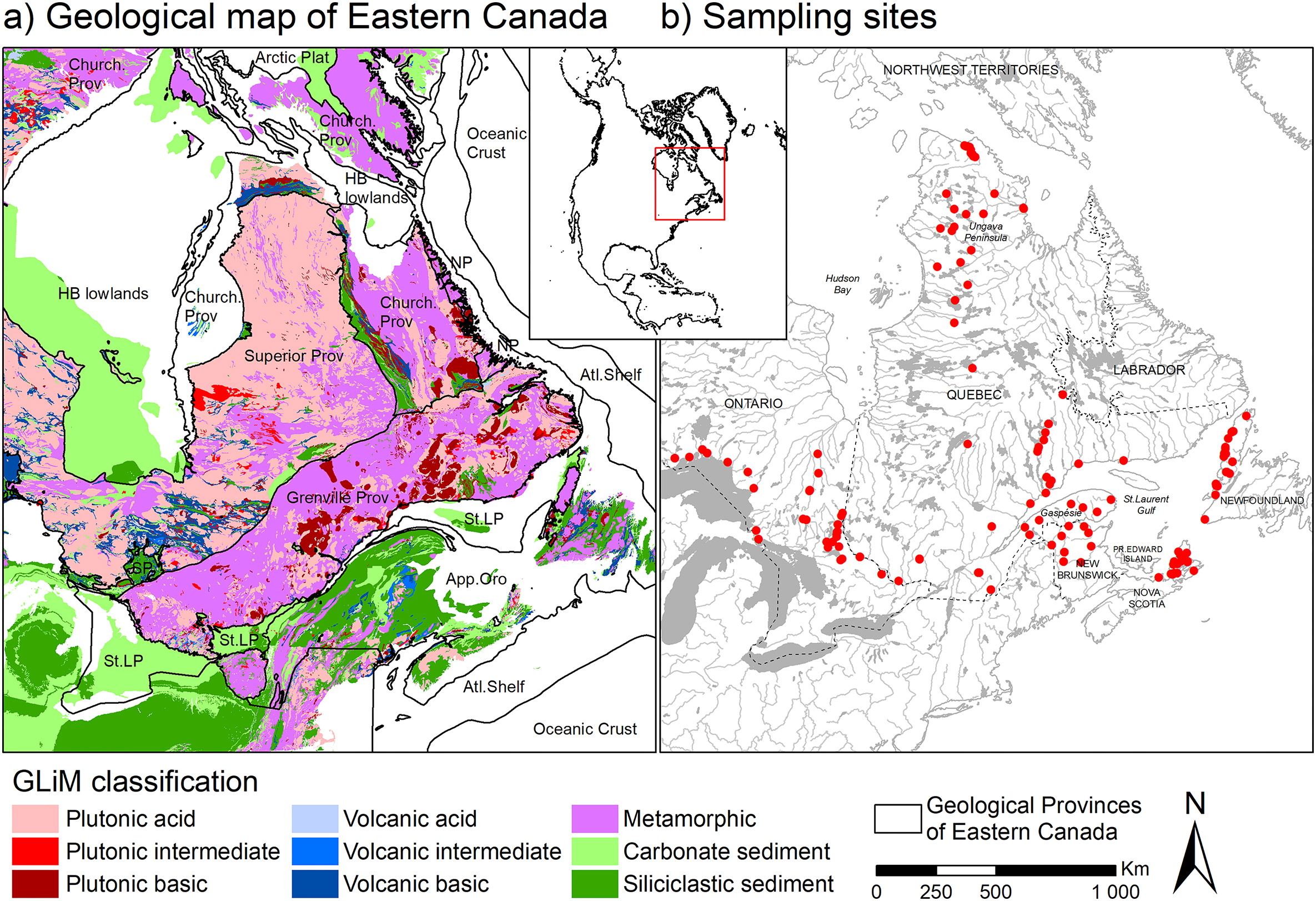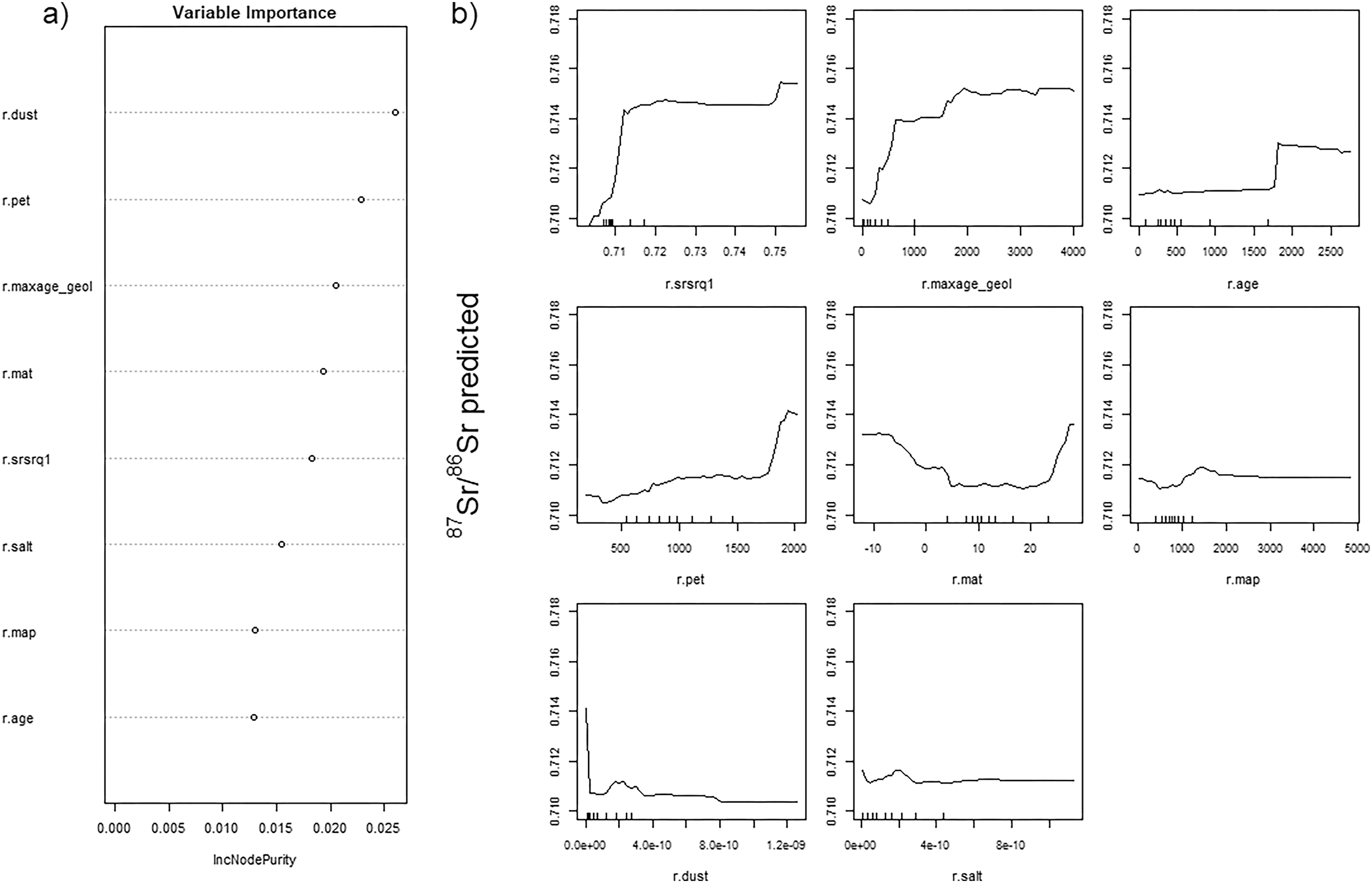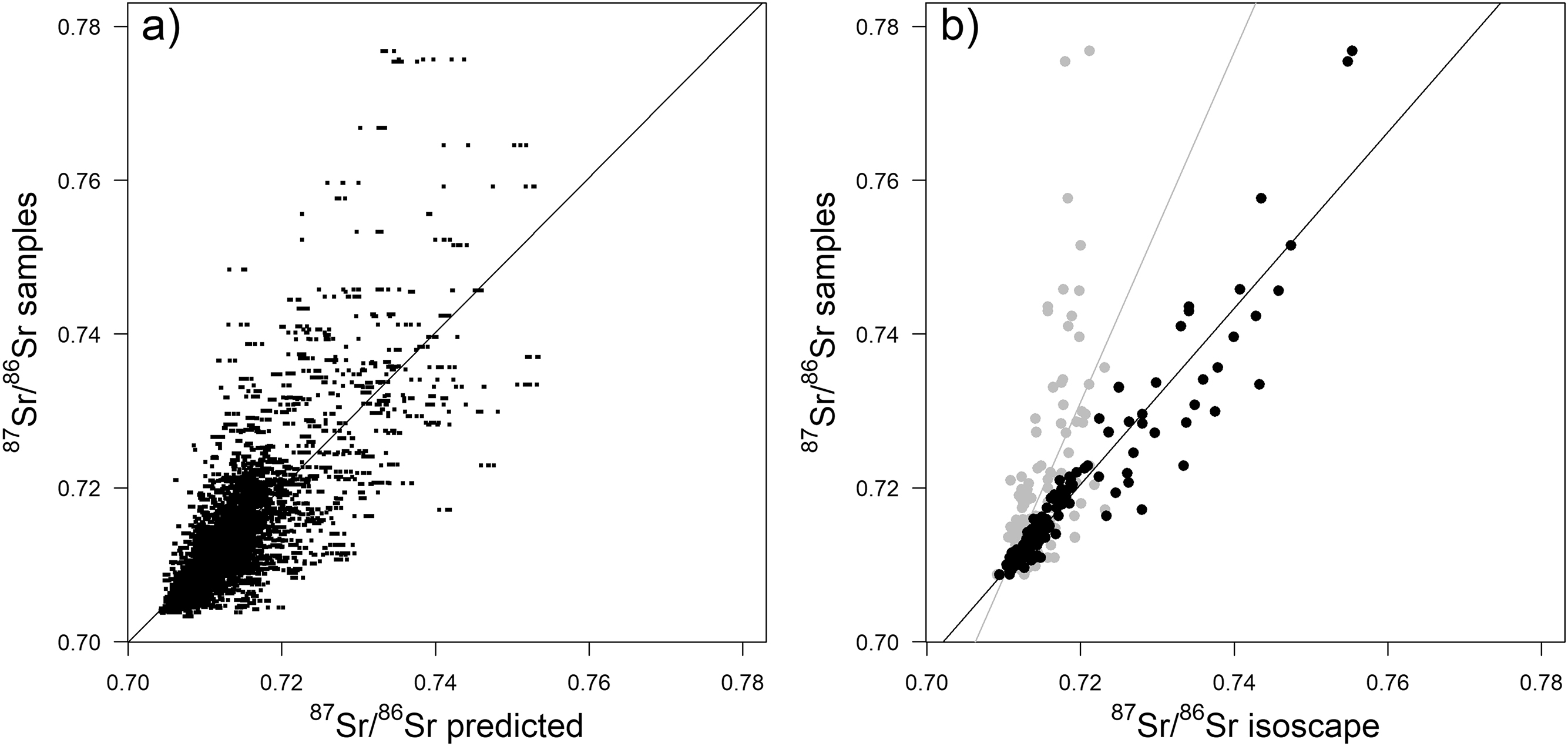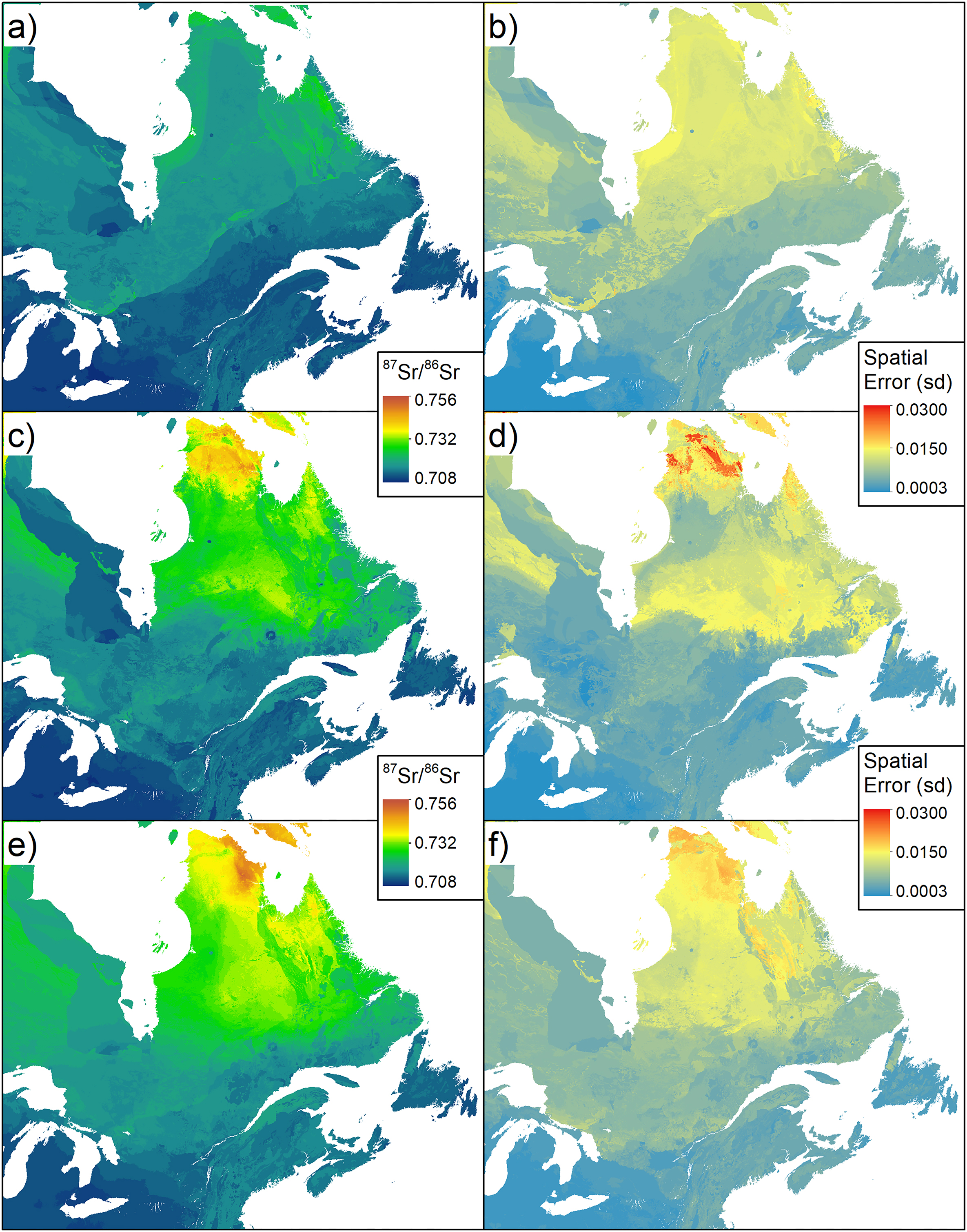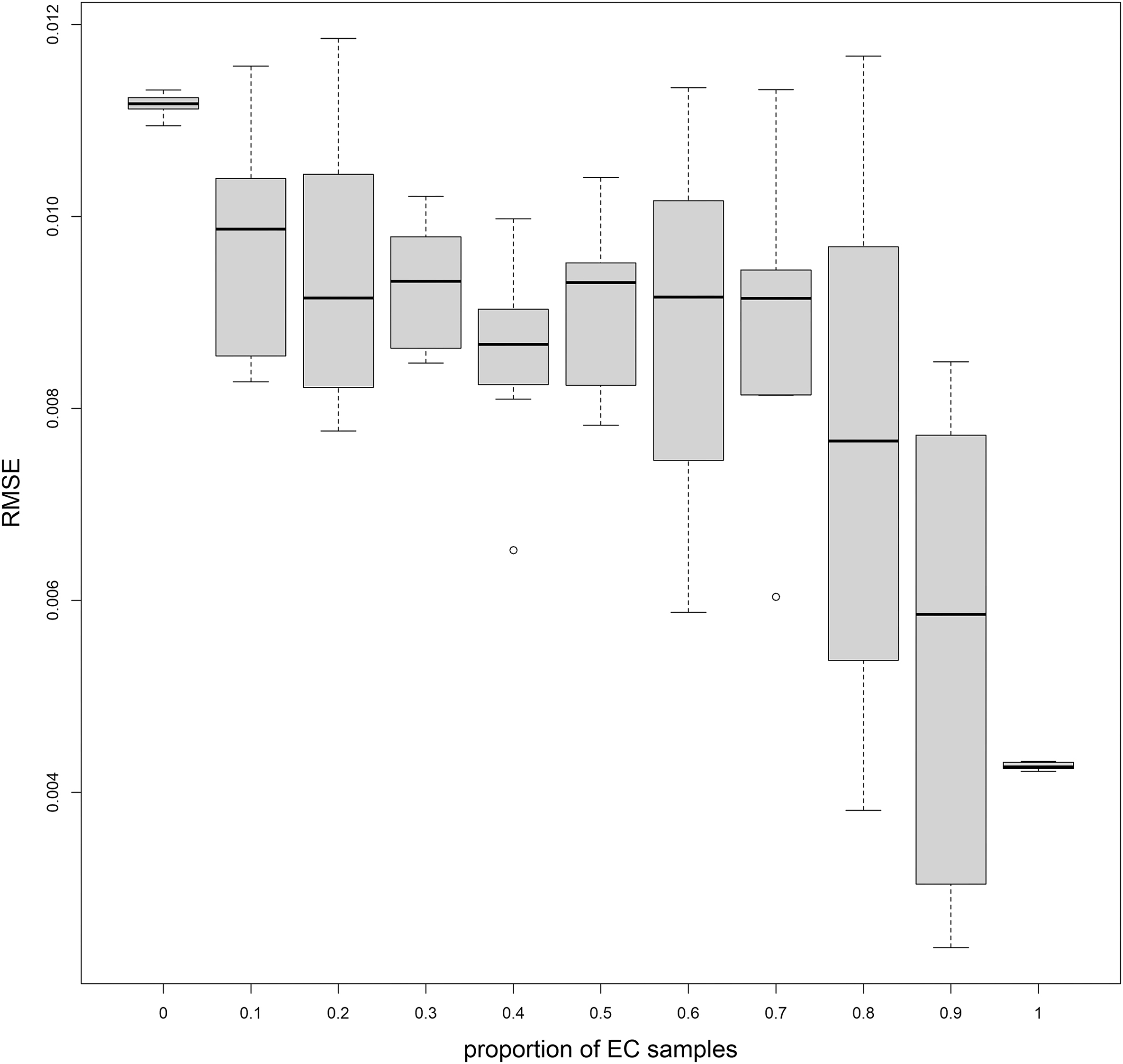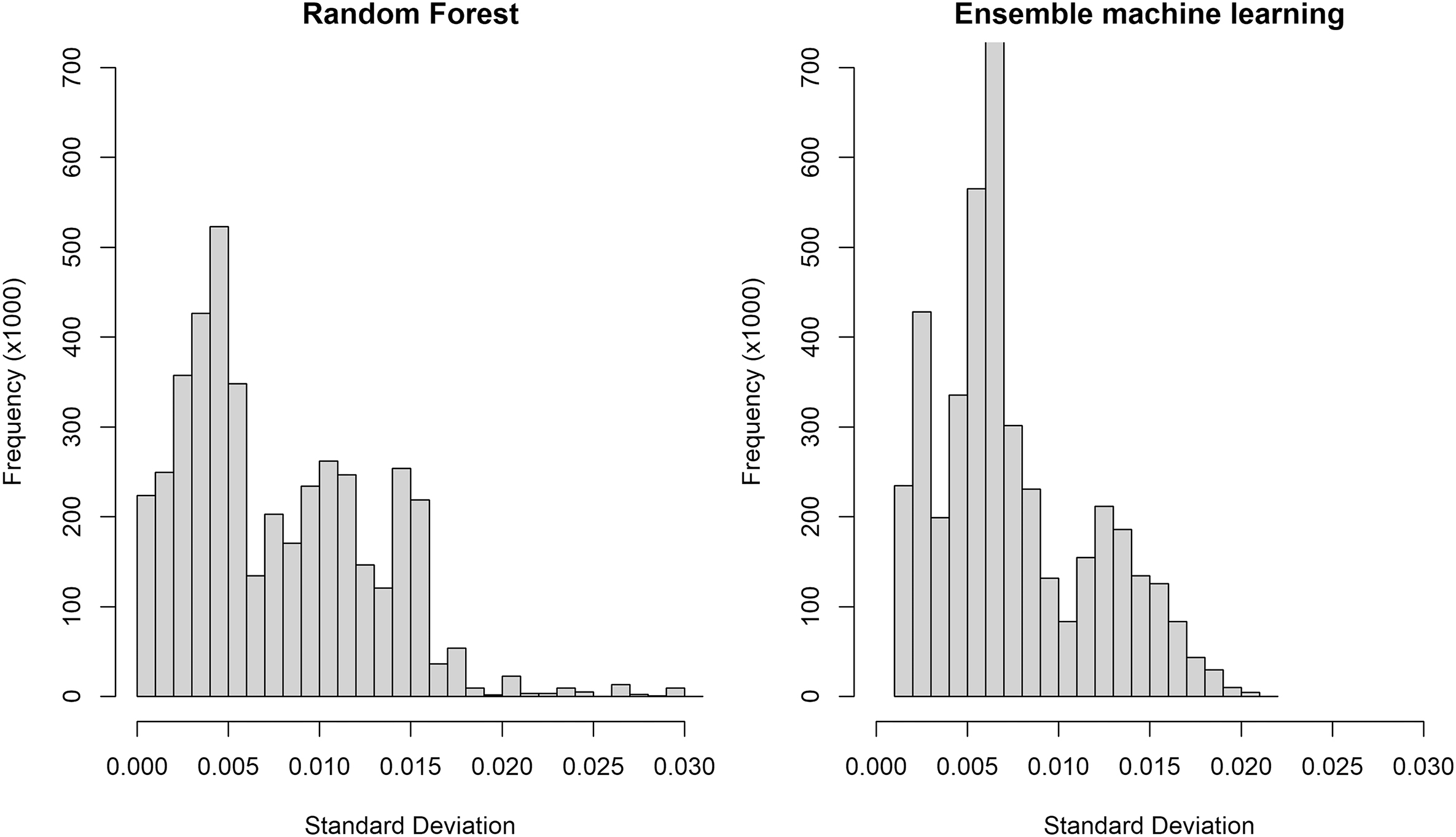1. Introduction
Strontium (Sr), and more specifically the isotope ratio
87Sr/
86Sr, is commonly used as an indicator of geographic origin and mobility in multiple fields of research (
Bentley 2006;
Baffi and Trincherini 2016;
Crowley et al. 2017;
Kamenov and Curtis 2017). Mainly driven in the environment by the nature of the underlying lithology through the weathering of the bedrock, the spatial distribution of bioavailable
87Sr/
86Sr (i.e., accessible for uptake by living organisms) across the landscape, displays stable scalar patterns that vary little at human timescales (
Capo et al. 1998). This stability and the unique mode of spatial variations of bioavailable
87Sr/
86Sr have made it a tool of choice for provenance studies. In archaeology, bioavailable
87Sr/
86Sr are often used to determine the origin of animal and human remains at archaeological sites and to determine whether the studied individuals were local or not. Such information can thus illuminate personal and group mobility, trading habits, origins, and interactions of past human populations (
Alt et al. 2014;
Coutu et al. 2016;
Shaw et al. 2016;
Madgwick et al. 2019a;
Britton and Le Corre 2022;
Czére et al. 2022;
Serna et al. 2023). Bioavailable
87Sr/
86Sr data are also useful in palaeoecological case studies to track the mobility of extant and extinct species unearthed at archaeological or palaeontological sites (
Britton et al. 2011,
2023;
Gigleux et al. 2019;
Wooller et al. 2021) and in modern ecology to follow the migratory movements and breeding grounds of birds, mammals, and insects (
Font et al. 2007;
Crowley et al. 2017,
2021;
Miller et al. 2021;
Reich et al. 2021). Lastly, bioavailable
87Sr/
86Sr datasets have also shown promise in the application of
87Sr/
86Sr analysis to certify, authenticate, and trace the origin of foods (
Baffi and Trincherini 2016) and forensic materials (
Kamenov and Curtis 2017). In parallel to the growing interest in, and applications of,
87Sr/
86Sr analysis in provenance studies, the tools and methods to map bioavailable
87Sr/
86Sr across the landscape have progressed (
Beard and Johnson 2000;
Bataille and Bowen 2012;
Bataille et al. 2018,
2020,
2021;
Funck et al. 2021;
Holt et al. 2021). While global bioavailable
87Sr/
86Sr predictions now exist and can be used for provenance, several studies have demonstrated that global bioavailable
87Sr/
86Sr isoscapes, a map of the spatial variations in isotopic values, show poor predictive power in data-poor regions (
Bataille et al. 2020;
Wang et al. 2023). Consequently, there is a major incentive to generate more bioavailable
87Sr/
86Sr data and to re-calibrate bioavailable strontium isoscapes at smaller scales and in data-poor regions.
The sole natural radiogenic isotope of strontium,
87Sr, is the product of the radioactive decay of
87Rb (rubidium). Due to this decay, the
87Sr abundance in rocks increases through time. Furthermore, ancient rocks with an initially high content of
87Rb, such as granite and rhyolite, are expected to have high
87Sr/
86Sr (
Bentley 2006;
Bataille et al. 2020). Conversely, younger rocks and (or) rocks with low
87Rb content, such as basalt or carbonate, are expected to have a lower
87Sr/
86Sr (
Bentley 2006;
Bataille et al. 2020). Through weathering and leaching, bedrock contributes as the main input to the
87Sr/
86Sr available in the soil for plants through pedogenesis (
Bentley 2006), alongside lesser inputs, such as sea spray, rainfall, or aeolian deposition (
Crowley et al. 2017;
Bataille et al. 2020). Bioavailable
87Sr/
86Sr is then absorbed by plants or ingested by animals through food and water consumption. In animals, strontium substitutes for calcium and is incorporated into hard tissues such as bones, tooth enamel, otoliths, and shells during growth and mineralisation (
Dahl et al. 2001;
Willmes et al. 2016;
El Meknassi et al. 2018;
Guiserix et al. 2022). During this process,
87Sr/
86Sr shows very low fractionation (
Guiserix et al. 2022), allowing for mass-dependent fractionation correction during analysis. Thus,
87Sr/
86Sr in plant and animal tissues reflects bioavailable
87Sr/
86Sr, and direct geographic inferences from the
87Sr/
86Sr of a given sample can be made with reference to bioavailable
87Sr/
86Sr.
In recent years, multiple methods have been used to map variability in the
87Sr/
86Sr of environmental samples (e.g., soils, plants) across landscapes and to produce isoscapes at different scales, mapping mean predictions and associated spatial uncertainty (
Bataille et al. 2018;
Holt et al. 2021). The most straightforward approach is to infer
87Sr/
86Sr directly from biological and soil samples. Strontium isotope ratios are
87Sr/
86Sr is estimated in samples collected across an area of interest and used to obtain an average
87Sr/
86Sr within specific sub-areas of known differences in their geological and lithological characteristics (
Evans et al. 2010;
Snoeck et al. 2020). Samples of interest (e.g., bones, archaeological remains, food products) are then compared to the previously generated spatial distribution of
87Sr/
86Sr to determine whether they are local or not, and (or) to identify their origin (
Vinciguerra et al. 2016;
Czére et al. 2022;
Dargent et al. 2023). Also, relying directly on biological and soil samples, geostatistical approaches, such as kriging with external drift, can be used to interpolate bioavailable
87Sr/
86Sr between sampling sites to produce
87Sr/
86Sr continuous distribution surfaces, accounting for the discrete distribution of the lithological units in the landscape (
Willmes et al. 2018;
Britton et al. 2020;
Lugli et al. 2022). Kriging also generates spatial uncertainty maps, allowing, in combination with the
87Sr/
86Sr continuous distribution surfaces, for probabilistic geographic assignment of the samples of interest (
Willmes et al. 2018;
Britton et al. 2020;
Lugli et al. 2022). A major limitation of direct inference and geostatistical approaches is that they require an extensive sampling effort to obtain well-defined isoscapes (
Bataille et al. 2018;
Holt et al. 2021) and large-scale isoscapes need to rely on large environmental
87Sr/
86Sr databases (
Willmes et al. 2018). Moreover, they are limited to the areas delineated by the sampling sites (
Holt et al. 2021). As such, these approaches may not be suitable in regions where extensive sampling is not feasible due to cost, accessibility, or scale.
Alternatively, process-based approaches have been proposed to predict the spatial distribution of
87Sr/
86Sr at large scales (
Bataille and Bowen 2012;
Bataille et al. 2020).
Bataille et al. (2014) developed a mechanistic model to predict
87Sr/
86Sr in bedrock according to bedrock age and lithology. The model relies on the known rate of radioactive decay of the
87Rb into
87Sr and, as a consequence, the increase in
87Sr/
86Sr of rocks through time. In such models, equations typically integrate bedrock age and the
87Rb/
86Sr ratio of actual and parent rock material (
Bataille and Bowen 2012;
Bataille et al. 2014). While these models can provide a strong baseline
87Sr/
86Sr bedrock isoscape, they may fail to reflect the bioavailable
87Sr/
86Sr spatial distribution, particularly for old and heterogeneous bedrock or in areas where other sources of bioavailable Sr (e.g., precipitation, aerosol deposits, fertiliser) are more influential (
Bataille et al. 2020;
Holt et al. 2021). Building on their mechanistic bedrock model,
Bataille et al. (2018) proposed a model based on a random forest regression (RF,
Breiman 2001), machine learning algorithm that integrates the process-based
87Sr/
86Sr bedrock isoscape and geospatial variables representing the potential auxiliary sources of Sr to ecosystems together into a regression. The model is trained on a dataset of bioavailable
87Sr/
86Sr from different analytes (i.e., plants, local animals, exchangeable soil Sr, water), compiled by
Bataiille et al. (2018,
2020), and predicts bioavailable
87Sr/
86Sr, alongside spatial uncertainty maps (
Bataille et al. 2018,
2020). This approach allows the predictions of bioavailable
87Sr/
86Sr at very large scales and in areas with low or no environmental sample coverage. However,
Bataille et al. (2020) also cautioned that this RF approach shows a limited power of extrapolation when predicting bioavailable
87Sr/
86Sr in regions without training data (
Bataille et al. 2020;
Wang et al. 2023). This caveat is especially true when predicting bioavailable
87Sr/
86Sr for which the geology, climate, or environments that are not well represented in the training dataset. For example,
Wang et al. (2023) showed that the global predictions of bioavailable
87Sr/
86Sr isoscape had very low accuracy in Angola, likely because the compiled training database has almost no samples for the old radiogenic cratonic regions and tropical areas typical of this region.
While RF generally outperforms other modelling methods to map bioavailable
87Sr
/86Sr (
Cutler et al. 2007;
Bataille et al. 2018), it only relies on a single algorithm to extrapolate predictions. Recent developments in numerical methods for mapping soil properties have emphasised the power of combining algorithms (e.g., ensemble learning), including RF, to improve the unbiasedness, extrapolation potential, and estimates of uncertainty of soil property predictions (
Wadoux et al. 2020;
Hengl et al. 2021). Another downside of the current RF framework relative to existing interpolation approaches is that it does not account for spatial autocorrelation in the calibration dataset (i.e., the spatial predictions and uncertainty estimates solely depend on geospatial predictors and are not influenced by the location of existing observations). Several approaches have been proposed to solve this issue, including adding geographical features such as buffer or oblique distances (
Møller et al. 2020) and combining multi-scale RF models (
Georganos et al. 2021).
Eastern Canada (EC) is an excellent location to test novel mapping approaches for bioavailable
87Sr/
86Sr. The geology, climate, and environment of this region are unique and not well represented by existing bioavailable
87Sr/
86Sr isoscapes (
Bataille et al. 2020). Yet, provenance studies using
87Sr/
86Sr analysis are growing (e.g.,
Stevenson et al. 2015;
Guibourdenche et al. 2020;
Pfeiffer et al. 2020;
Fauberteau et al. 2021;
Dargent et al. 2023). The geology of EC is dominated in the north by the large Canadian craton composed of a diversity of plutonic and metamorphic geological provinces and units dating from the Archaean and Proterozoic periods (
Shilts et al. 1987). Due to its old age and a range of lithology with distinct Rb content, very broad
87Sr/
86Sr variations are expected in the bedrock of this region (and thus in that of its soils and plants). Conversely, south of the St. Lawrence River, Palaeozoic marine sedimentary formations, igneous and metamorphic units of the Appalachian mountains, Pleistocene glacial sediments, and Champlain Sea deposits (
Thériault and Beauséjour 2012) dominate the landscape and contribute to probably lower but variable bioavailable
87Sr/
86Sr in that area. Although incorporating a few data from the European craton, the database of globally compiled bioavailable
87Sr/
86Sr mainly consists of samples with bioavailable
87Sr/
86Sr below 0.720 and lacks samples from areas of higher bioavailable
87Sr/
86Sr such as those originating from old, highly radiogenic regions of the Canadian craton (
Bataille et al. 2020). Moreover, the Global Lithological Map (GLiM,
Hartmann and Moosdorf 2012) used to build the mechanistic bedrock
87Sr/
86Sr model (
Bataille et al. 2014), which is the main predictor of bioavailable
87Sr/
86Sr, relies on outdated and low-resolution geological data. In addition to its unique geology, EC also shows a unique climate with temperate forests characterised by cold, snowy winters and warm humid summers in southern EC, boreal forests with colder sub-arctic climates in central EC and tundra-like peatland environments in the northern EC. Incorporating bioavailable data from this geologically and environmentally unique region is thus essential to further improve regional and global
87Sr/
86Sr isoscapes.
Besides its direct interest as an undersampled testing site to improve the modelling and coverage of bioavailable
87Sr/
86Sr, EC is also known for its local agricultural production, thriving forest industry, biodiversity, and the historical presence of Inuit and First Nation communities, which could all benefit from the development of provenance tools. Provenancing using
87Sr/
86Sr has shown potential in food sciences and food forensics in the region, for example, to certify the origins of locally produced wine (
Vinciguerra et al. 2016;
Guibourdenche et al. 2020), cheese (
Stevenson et al. 2015) and maple syrup (
Nguyen et al. 2023). Similarly, bioavailable
87Sr/
86Sr have been used to trace the origin of human remains from their tissues to investigate cold cases (
Fauberteau et al. 2021), to trace the origin of historical immigrants in the Montreal region (
Vautour et al. 2015), and to reconstruct the history of movements of First Nations people (
Pfeiffer et al. 2020). In forestry, the recent application of
87Sr/
86Sr in Canada showed its potential to trace the dispersal and population connectivity of forest pests destroying the boreal forest, such as the eastern spruce budworm moth (
Choristoneura fumiferana,
Dargent et al. 2023). Finally, the large and remote landscape of EC is increasingly affected by human disturbances and warming that are rapidly changing the suitability of breeding grounds, migration routes and habitats of the many mammals, birds and insect species that inhabit this region (
Foster et al. 2022). These changes in mobility and habitat suitability are one of the major drivers of the rapid population decline of many of these boreal species (
Vors and Boyce 2009;
Gauthier et al. 2013). There is therefore an urgent need to develop tools that can allow the generation of modern and historic datasets, such as bioavailable
86Sr/
87Sr, to better understand past and present changes in the mobility, range, and seasonal breeding sites of this priceless biodiversity resource.
In this paper, we aimed to develop an accurate, unbiased, and regionally calibrated isoscape for EC by adding new plant samples collected in the region to the global database from
Bataille et al. (2020), and by updating the bedrock model and the geological variables for EC with a more recent and accurate lithological map (
Thériault and Beauséjour 2012). We also tested a new mapping approach by comparing the traditional RF approach from
Bataille et al. (2020) to a spatial interpolation ensemble machine learning (EML) approach (
Hengl et al. 2021) to explore how ensemble learning can improve model predictions and spatial uncertainty estimates. We conclude by discussing the potential of this new isoscape for provenance studies in the region.
4. Discussion
Building on the previously published global bioavailable
87Sr/
86Sr isoscape (
Bataille et al. 2020), we produced a
87Sr/
86Sr isoscape for EC using random forest and EML approaches. We added 136 sampling sites specific to EC to the original dataset of
Bataille et al. (2020), improving our ability to predict bioavailable
87Sr/
86Sr for this region. Moreover, we updated the geological auxiliary variables (e.g., age, lithology) using baseline lithological information for Québec with more recent and high-resolution data. Regardless of the modelling approach (RF or EML), these updates improved the spatial prediction bioavailable
87Sr/
86Sr across our study area with higher
87Sr/
86Sr ratios in the northern geological provinces of EC, in agreement with the
87Sr/
86Sr ratios observed in our plant samples and in the literature.
The addition of EC sampling sites to the original global isoscape database (
Bataille et al. 2020) increased the predicted bioavailable
87Sr/
86Sr ratios of the old, highly radiogenic Canadian craton. Conversely, bioavailable
87Sr/
86Sr ratios in the southern provinces (i.e., Grenville Province, the St. Lawrence platform, and the Appalachian orogeny) remained similar to predictions from
Bataille et al. (2020). These provinces are dominated by carbonate and siliciclastic sedimentary units and metamorphic units, which are tectonically related to coeval North American and European units (
Hartmann and Moosdorf 2012). As the global bioavailable
87Sr/
86Sr isoscape from
Bataille et al. (2020) was mostly trained on data-rich regions from the USA and Europe with similar lithology and climate as in southern EC, the southern EC regions show accurate bioavailable
87Sr/
86Sr predictions. The addition of new bioavailable
87Sr/
86Sr data from the southern EC regions only marginally improved bioavailable predictions because the machine learning model is already well informed for locations with similar lithology and environment (
Bataille et al. 2020). Conversely, the
Bataille et al. (2020) model performed poorly for northern EC due to the lack of bioavailable
87Sr/
86Sr training data for highly radiogenic cratonic regions (i.e., less than 2% of the sites from the original database had a bioavailable
87Sr/
86Sr above 0.730). In this case, even a limited number of new sites, such as the sites we added from the Superior Province, strongly helped to inform the model and drastically changed the predictions and uncertainty estimates for EC. While local predictions had a better fit with the locally calibrated bioavailable
87Sr/
86Sr, the model performance only slightly improved because adding 136 sampling sites to a database of more than 4000 sampling sites globally (∼3% addition) only had a marginal effect on the overall model performance. The spatial uncertainty estimates increased significantly in northern Canada for the locally calibrated model relative to the global model because the collected bioavailable
87Sr/
86Sr in northern EC showed a large range of ratios. This suggests that the machine learning model is not yet sufficiently informed in those regions and would require higher sampling density to reduce the uncertainty of the predictions across this old and lithologically heterogeneous region of the Canadian craton despite a relatively good accuracy. Similar results were found in other data-poor regions, where adding few samples improved the local model accuracy (
Bataille et al. 2020;
Wang et al. 2023).
The need for additional bioavailable
87Sr/
86Sr data for EC is supported by the local cross-validation exercise (
Fig. 5). If using the entire dataset to train a local model, this type of local cross-validation is an important step to assess the true performance of the bioavailable
87Sr/
86Sr isoscape locally. We note that RMSE slowly decreased when incorporating 10%–70% EC samples into the RF training dataset (
Fig. 5) then dropped for 80% and 90% EC samples. While this RMSE was lower than when no local EC samples were integrated into RF models (RMSE = 0.0112), it was much higher, even when using 90% of the EC dataset, than the RMSE found for RF
alldata (model RMSE = 0.0035) and the associated local EC samples (EC data RMSE = 0.0043). This higher RMSE is not surprising because northern EC is a highly radiogenic region with heterogeneous geology and more variable bioavailable
87Sr/
86Sr than many other regions of the world. This is visible in the much higher spatial uncertainty in this region (
Fig. 4). Additionally, only a small portion (≈25%) of our EC dataset includes samples from northern, radiogenic EC. A large proportion of those local EC samples need to be included to see an increase in the performance of the RF model (
Fig. 5). The fact that RF for 10%–90% of EC samples incorporated samples selected randomly (i.e., RF built on different datasets) increases the variability in model performance, while for 0% and 100%, for which the datasets do not change, the low variability in the RMSE estimates is solely attributable to the internal randomness of the RF algorithm. These results suggest that with every additional training sample, the model is still learning, indicating that more samples might be required to appropriately train this geologically heterogeneous cratonic area.
Variables retained to train the RF with and without EC data (RF
alldata and RF
noEC, respectively) were almost identical and were consistent with
Bataille et al. (2020). Differences occurred on low-ranked predictors according to the variable importance index, likely reflecting the stochasticity of the RF approach (
Breiman 2001) The importance of the dust deposition variable has potentially been artificially amplified by the spatial distribution of the samples from the dataset: old and highly radiogenic regions sampled (EC, Scandinavia, Madagascar) are exposed to extremely low dust deposition. Regions heavily exposed to dust deposition are poorly represented in the dataset, and an additional sampling effort in these regions would help to better assess the importance of the dust variable. Trends observed on partial dependence were consistent between RF
noEC and RF
alldata and
Bataille et al. (2020). As expected, bioavailable
87Sr/
86Sr increased with
87Sr/
86Sr from bedrock and with bedrock age (
Bataille et al. 2014,
2020). A recent application of the RF in New Zealand (
Kramer et al. 2022), but using a smaller bioavailable
87Sr/
86Sr dataset than
Bataille et al. (2020), showed different trends in some predictors (e.g., salt deposition, mean annual temperature). Such differences are likely to reflect geographic biases and do not have clear mechanistic significance. They underline the need to build local bioavailable
87Sr/
86Sr isoscapes using global bioavailable datasets instead of training them with small regional datasets. This strategy will avoid overfitting relationships between bioavailable
87Sr/
86Sr and predictors yielding the most generalisable model beyond the training points.
The
n-fold cross-validation of the EML
alldata demonstrated similar performance to the typical RF framework. The EML
alldata model was largely dominated by RF (highest absolute
t value,
Table 2) and, to a lesser extent, by support vector machine, but other learners were not as influential. Overall, the use of multiple learners did not improve the model accuracy but enhanced the robustness of the resulting model due to spatial cross-validation (
Hengl et al. 2021). As expected from the dominance of RF in the EML predictions, the EML
alldata isoscape showed patterns very similar to RF
alldata (
Fig. 4). The main difference between spatial interpolation EML and RF-based modelling appeared when comparing the spatially explicit uncertainty maps with the EML isoscape displaying a more pronounced bimodal distribution, less positively skewed, with two normal modes (
Fig. 6) reflecting the high heterogeneity of the old craton in the north and the lower variability of the younger sedimentary units in the south. The EML isoscape algorithm incorporates spatial dependencies and uses an unbiased spatial cross-validation approach, leading to more robust uncertainty estimates (
Hengl et al. 2021). However, this approach is best applied to local or regional bioavailable
87Sr/
86Sr predictions as computational time becomes prohibitive for larger datasets with thousands of bioavailable
87Sr/
86Sr ratios (
Hengl et al. 2021). Additionally, the EML framework lacks direct interpretability (i.e., there is an absence of partial dependence plots or importance of predictors), so we still recommend using the RF-based modelling approach as a basis to select predictors and discuss bioavailable
87Sr/
86Sr patterns before using the EML to produce the most accurate and unbiased
87Sr/
86Sr isoscape.
Further increasing the accuracy of the isoscape would require extensive sampling across EC. Intensive sampling is difficult to achieve in remote areas such as the Superior and Churchill Provinces, although collaboration with First Nations and Inuit communities and research networks conducting remote field studies may help overcome this problem. However, increasing the number of sampling sites may not be sufficient to reduce the variability in very old felsic rock units to levels similar to that of younger units. Old felsic rocks are heterogeneous with minerals having vastly different
87Sr/
86Sr and weathering at different rates (
Clow et al. 1997), leading to high intra-site variability (
Bataille et al. 2020). Another limit of our isoscape relates to the limited number of sites across EC relative to other regions of the world. The original global dataset has a geographic bias toward the USA and Europe (
Bataille et al. 2020). The link between a given predictor and the predicted
87Sr/
86Sr in the global dataset may therefore not be representative of local processes, such as those observed for climate and atmospheric deposition variables (
Bataille et al. 2020;
Kramer et al. 2022). To refine local prediction and increase accuracy, ongoing development of the RF approach should seek to account for the spatial distribution of the sampling sites (
Hengl et al. 2021;
Møller et al. 2020) and to integrate local variation by weighting prediction according to the distance to the sampling sites (
Sekulić et al. 2020) or to local RF (
Georganos et al. 2021). However, these approaches require a relatively good spatial distribution of samples, which was not the case for our EC sampling sites. Using RF to extrapolate
87Sr/
86Sr in regions with little or no data, especially in old radiogenic areas, is less reliable than in data-rich regions, and predictions should be made with caution (
Bataille et al. 2020). However, we are confident in our isoscape as the predicted bioavailable
87Sr/
86Sr showed good agreement with the sampling sites and are consistent with the
87Sr/
86Sr from the region published in other studies (
Britton 2010;
Stevenson et al. 2015;
Vinciguerra et al. 2016;
Dargent et al. 2023).
In recent years, several provenance studies generated bioavailable
87Sr/
86Sr for food and animals from EC that support the predictions of our models. For example, in the north, the
87Sr/
86Sr predictions are consistent with caribou (
Rangifer tarandus)
87Sr/
86Sr enamel profiles from two migratory herds, the Rivière-aux-Feuilles herd and the Rivière-George herd, ranging across Québec and Labrador (
Britton 2010). The range of the
87Sr/
86Sr observed in enamel in the study (0.718-0.738,
Britton 2010) falls within the range of the bioavailable
87Sr/
86Sr observed on their annual ranges covering the Superior, Churchill, Nain Provinces, and northeast Grenville Province (
Le Corre et al. 2020). Moreover,
87Sr/
86Sr variations in the teeth reflect known seasonal movements, particularly for the Rivière-aux-Feuilles herd (
Le Corre et al. 2020), with increasing
87Sr/
86Sr values along the third molar mirroring the movement from the winter range (
Le Corre et al. 2023), which encompasses the southern metamorphic region of the Superior Province in Québec, to the highly radiogenic region of the summer range in the north-west Ungava Peninsula. In the south, the isoscape is consistent with the
87Sr/
86Sr measured in eastern spruce budworm moths (
Dargent et al. 2023) with low ratios found along the coast of New Brunswick, Prince Edward Island, and Newfoundland (0.711-0.713), and higher ratios on the northern and southern banks of St. Lawrence River and in Gaspésie (0.715-0.718). Consistencies can also be found with data from cheese (
Stevenson et al. 2015) and wine (
Vinciguerra et al. 2016) studies in southern Québec.
With its unique, predictable, and stable patterns on the landscape, bioavailable
87Sr/
86Sr could become a key monitoring and management tool for EC natural resources. With this developed isoscape, we have established a basis to use
87Sr/
86Sr provenancing across the EC region. The EC landscape, with its broad socio-economic and biological resources, is essential to EC's economy and wealth; it also shelters great biodiversity and is the ancestral home of many Inuit and First Nations communities. Climate change and human activities are rapidly degrading EC's ecosystems and food systems (
Downing and Cuerrier 2011;
Foster et al. 2022). Many native species are endangered, while others (e.g., insect pests, invasive species) have seen population outbreaks costing billions of dollars annually (
Logan et al. 2003). Changes in mobility are one of the key drivers of population demographics for animal species (
Berger 2004;
Robinson et al. 2009). Quantifying these changes through time is thus key to developing species-specific strategies to either limit (e.g., pests) or favour (e.g., endangered species) population growth. However, monitoring animal mobility is often difficult for species with large populations, species with short lifespans (e.g., insects), and species living in remote habitats (e.g., caribou). Moreover, the practical requirement for historic data that go beyond primary observations and records necessitates the development of proxy methodologies focused on historic, archaeological, or palaeontological materials. Afterall, many population drivers operate over decadal timescales requiring long-term population baselines to refine management strategies (
Lindenmayer et al. 2022). Strontium isotopes could become particularly relevant to manage the biodiversity and resources of the huge EC landscape, especially for remote areas. For example, limiting the spread of eastern spruce budworm outbreaks (the most destructive insect pest of the EC boreal forest) requires the monitoring of the long-distance dispersal and connectivity of eastern spruce budworm moths, to intervene early in zones vulnerable to future outbreaks. EC would benefit from improved tools to control and mitigate those outbreaks, and the combination of hydrogen and strontium isotopes has shown promise as a way to monitor their dispersal and connectivity across the impacted regions (
Dargent et al. 2023). Another example of potential use of strontium isotopes in EC is to trace the migration and range of eastern migratory caribou (
Gigleux et al. 2019;
Miller et al. 2023), a species central to subsistence for many Inuit and First Nations communities. With habitat alteration, human impact, climate change, and increased predation associated with the rapid development of EC, the eastern Canadian caribou population has shown a 90% decline over the last decades. For many sub-populations, demographic collapse was preceded by a change in range and mobility habits in response to human disturbances (
Festa-Bianchet et al. 2011). Conserving this species will require delineating protected areas that would accommodate for range variations to allow the species to respond to future disturbances. The strontium isotope composition of caribou teeth preserves a record of the individual's mobility (
Britton et al. 2009;
Gigleux et al. 2019;
Le Corre et al. 2023). Historical collections of caribou skeletal remains are available in museums and can be used to better delineate the long-term historical range and seasonal mobility of herds, and to help identify suitable protection areas for those endangered populations. The strontium isoscape for EC developed here therefore has immediate applicability to inform EC conservation and pest management policies for the selected species but is potentially transferable to other species (e.g., invasive species, migratory birds) with short- and long-term benefits for managing EC's historic and natural resources and biodiversity.
